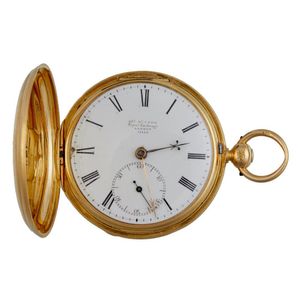19th Century 18ct Gold Full Hunter Watch by McCabe
You must be a subscriber, and be logged in to view price and dealer details.
Subscribe Now to view actual auction price for this item
When you subscribe, you have the option of setting the currency in which to display prices to $Au, $US, $NZ or Stg.
- Movement - The technical name for the workings of a clock or watch, and does not include the dial or case.
- Fusee - The fusee movement was used in clocks and pocket watches from the mid 17th century. The fusee is a cone shaped drum within the works that is linked to the barrel of the spring, usually by a length of chain.
As the mainspring loses its tension over time, the cone shaped barrel compensates for this by increasing the tension, by pulling the mainspring tighter, thus ensuring the time remains constant.
Use of the fusee in clocks was superseded by the "going barrel" in the mid 19th century and for pocket watches at the beginning of the 19th century.
The fusee continued to be used in marine chronometers until the 1970s. - Hunter - A hunter pocket watch is the type where the case includes a spring-hinged circular metal lid or cover, that closes over the glass face of the watch, protecting it from dust, scratches and other damage or debris. The majority of antique and vintage hunter-case watches have the lid-hinges at the 9 o?clock position, suiting the right handed user.
- Engine Turned - Engine turning is a decorative technique used on metal surfaces to create intricate curving or geometric pattern. The process involves cutting a series of lines into the surface of the metal using a rose engine or decoration lathe which rotates the metal as it cuts, allowing the operator to create a repeating pattern that covers the entire surface. The resulting surface has a shimmering, reflective quality that is often described as "engine turned." Where an engine turned item has been enamelled, the term used to describe the decoration is usually guilloche.
Engine turning was originally developed to decorate metal objects such as firearms, scientific instruments, and other metal objects that required precise and elegant design. - Back Plate - On many types of clocks, the movement operates between two plates, usually made of brass, one at the back, and the other at the front, which forms a mount for the dial.
On English bracket, mantle and table clocks the backplate was often visible through a glass door or panel from the late 17th century, and could be profusely engraved with scrolling decorations, flowers, foliage, birds, and figures. The engraving could also include the maker?s name.
The amount of engraving reduced and became simpler as the 18th century progressed, and by 1800, had been reduced to a border, often with the maker's name in the centre. By the early 1800s all decoration had ceased, and only the maker's name was added, and by the Victorian era, most bracket, mantle and table clocks had no engraving.
This item has been included into following indexes:
Visually similar items

Robert Roskell Liverpool an 18ct gold hunting cased watch Mvt 61321, circa 1860, fusee lever movement, key wind and set, white enamel dial, Roman numerals, outer minute track, polished case engraved with blank cartouche, dial and movement signed, diameter

An 18ct gold chronograph watch, Nicole Nielsen & Co., mvt 12473 case 12473, circa 1900 Gilt lever movement, bi-metallic compensation balance, highly jewelled, white enamel dial, Roman numerals, subsidiary dials at 6 and 12 o'clock indicating constant secon

Lady's 14ct gold full hunter watch, white dial, Roman numerals, push pin at one o'clock, lever movement in a finely engraved case, diameter 34 mm, wt. 31.9g, not working

A Rolex gold hunter pocket watch, crown wind movement, circular white dial with Roman numerals, subsidiary seconds dial at six, signed dial and movement, engine turned 18ct gold case, 48 mm diameter, hallmarked Birmingham 1923-24
